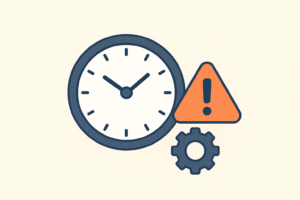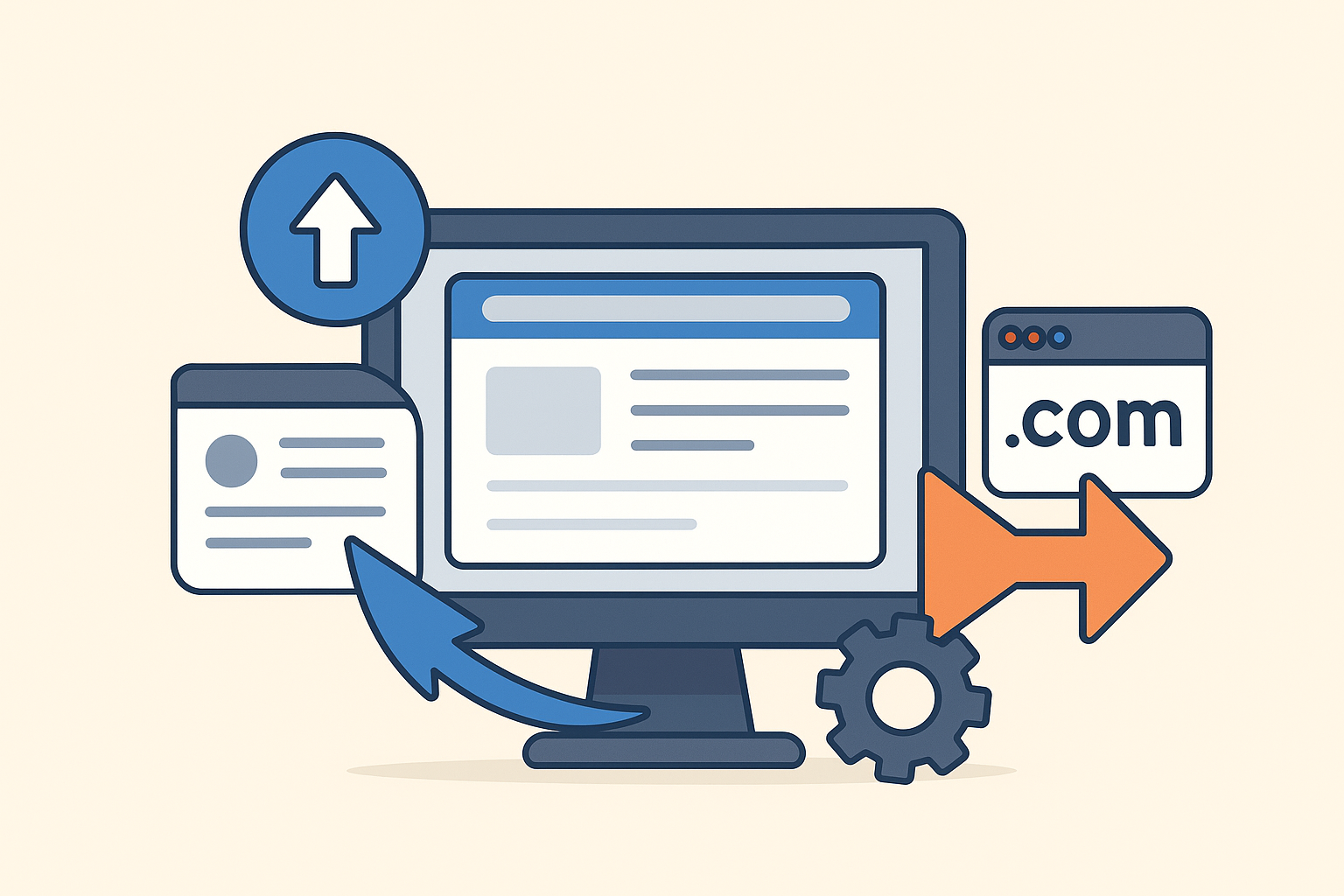In the ever-evolving digital landscape, a seamless Website and Domain Migration Service is vital for businesses seeking to move their online presence to a new platform or domain without losing performance, traffic, or visibility. Whether shifting to a more secure hosting provider, changing your website’s CMS, or updating your domain for branding reasons, professional migration ensures every piece of data — from files and emails to SEO settings — transfers safely. Without proper planning, a website migration can lead to downtime, data loss, or ranking drops. That’s why expert migration management is essential for maintaining website stability, SEO integrity, and brand trust.
Introduction
Migrating a website and its domain is one of the most critical yet complex digital processes a business can undergo. A well-executed Website and Domain Migration Service ensures your online assets are transferred smoothly, with zero downtime and no compromise on data or SEO performance. Whether you are rebranding, upgrading hosting, or moving to a new CMS, migration plays a pivotal role in maintaining continuity and user trust.
At FixHackedSite, we understand how vital website stability and data protection are during migration. Our team focuses on precision, speed, and technical care to guarantee that your migration process is not just about moving files — it’s about safeguarding your business’s online reputation and growth. From mapping URLs to preserving SEO rankings, every step of our migration strategy is tailored to minimize disruption while maximizing performance.
A professional migration isn’t merely a technical task; it’s a strategic move. When done correctly, it can significantly enhance your website’s security, speed, and scalability. However, without expert assistance, migration risks can escalate quickly — leading to broken links, lost emails, or ranking penalties. That’s why partnering with a specialized service ensures your digital foundation remains strong and resilient through the entire process.
Understanding Website and Domain Migration
Before diving deep into the technicalities, it’s important to understand what website and domain migration truly involves. Migration means more than just transferring website files from one host to another. It’s a multi-layered operation that includes moving databases, updating configurations, maintaining URL structures, and preserving SEO elements like meta tags and sitemaps. Domain migration, on the other hand, deals specifically with changing the website’s address — for example, from “www.oldsite.com” to “www.newsite.com.”
A proper Website and Domain Migration Service handles both aspects seamlessly. This involves backing up all website content, setting up redirects, verifying email systems, and testing functionality after migration. The goal is to ensure users never feel the transition. The process should be so smooth that visitors continue interacting with your website without noticing any interruptions.
Migration also impacts SEO in significant ways. If URL structures change or old links aren’t redirected properly, search engines may perceive it as new content, potentially causing ranking losses. Therefore, an experienced migration team not only focuses on the technical side but also on preserving the SEO health of the website. In today’s digital world, such attention to detail separates a successful migration from a disastrous one.
Importance of a Professional Migration Service
A professional Website and Domain Migration Service ensures that your digital move is executed flawlessly. The process involves several technical layers that require expertise in hosting, databases, and web development. Even a small error, such as missing redirects or broken links, can lead to severe downtime and revenue loss. That’s why businesses that rely on their online presence must never treat migration as a DIY task.
 One of the most overlooked benefits of professional migration is data security. During transfers, your website’s files, databases, and customer information are vulnerable to corruption or loss. An expert migration team implements safety protocols and backup systems to ensure every byte of data remains intact throughout the transition. This not only safeguards business continuity but also enhances overall trustworthiness.
One of the most overlooked benefits of professional migration is data security. During transfers, your website’s files, databases, and customer information are vulnerable to corruption or loss. An expert migration team implements safety protocols and backup systems to ensure every byte of data remains intact throughout the transition. This not only safeguards business continuity but also enhances overall trustworthiness.
Additionally, professional services understand the SEO impact of migration. From setting up 301 redirects to reindexing the new domain, every step is handled strategically. A well-planned migration doesn’t just protect rankings — it can even improve them by enhancing performance, load speed, and server response times. When done professionally, migration becomes an opportunity to strengthen your site’s technical foundation and prepare it for future scalability.
Common Reasons for Website and Domain Migration
Businesses choose to migrate their websites and domains for various reasons. One of the most common motivations is rebranding — when a company updates its name, logo, or image, changing the domain is often a natural step. This transition must be smooth to retain SEO authority and ensure customers can still find the site easily. A professional Website and Domain Migration Service manages this process while maintaining link equity and brand visibility.
Another major reason is hosting improvement. Many businesses outgrow their current hosting providers or face frequent downtimes. Migrating to a more reliable, secure, and faster host ensures that your website performs better and delivers a smoother user experience. In today’s fast-paced digital world, even a few seconds of downtime can lead to customer frustration and revenue loss.
Sometimes migration becomes necessary for security or compliance reasons. Older platforms or hosting environments may not meet modern cybersecurity standards, exposing your site to vulnerabilities. Migrating to a more secure server or CMS can drastically reduce these risks. Whether for performance, branding, or protection, migration is a strategic move that directly impacts the growth and longevity of your digital presence.
Challenges During Website Migration
Migrating a website is far from a simple copy-and-paste task. One of the biggest challenges is ensuring that no data or SEO authority is lost during the transition. A professional Website and Domain Migration Service must carefully handle redirects, DNS propagation, and server configuration. Even a minor error in any of these can cause downtime or broken links, which negatively affect both user experience and search rankings.
Another common challenge is dealing with complex databases. Many websites today rely on CMS platforms such as WordPress, Joomla, or Magento, which store large volumes of data. When migrating, ensuring that these databases remain consistent and error-free requires deep technical expertise. Data mismatches or incomplete imports can disrupt the functionality of plugins, forms, or e-commerce systems.
Lastly, maintaining email continuity is crucial. Many domains have linked email systems, and if not handled properly, users may lose important messages or face downtime in communication. That’s why professional migration experts use verified protocols and perform multiple tests post-migration to ensure every component — from the website to emails — works flawlessly on the new setup.
Preparing for Website and Domain Migration
Before initiating any migration, preparation is the key to success. A professional Website and Domain Migration Service begins by conducting a detailed audit of your current website, identifying all assets, databases, links, and dependencies. This audit helps determine what needs to be transferred, what can be optimized, and what might be redundant. Preparing a complete backup is essential at this stage — ensuring that if anything goes wrong during migration, you can restore your website without losing any data or content. Every small element, from media files to configuration settings, must be cataloged and safely stored.
The next step in preparation involves creating a migration plan and timeline. The plan should outline each step of the process — from file transfer to DNS changes — and specify who is responsible for every task. Proper scheduling ensures minimal downtime and keeps all team members aligned. Additionally, performing the migration during off-peak hours can reduce the impact on user experience. This strategy ensures that even if small disruptions occur, they won’t significantly affect customer interactions or business operations.
Finally, technical readiness must be ensured. This includes verifying server compatibility, domain settings, SSL certificates, and CMS or plugin versions. Before launching the migration, a staging environment is often set up — a duplicate of the live site where migration can be tested safely. This environment allows developers to identify potential issues in a controlled setup before pushing changes to the live website. Effective preparation minimizes risks, saves time, and guarantees a smoother, faster transition when the actual migration begins.
Creating a Detailed Migration Checklist
Having a detailed checklist is one of the most powerful tools during migration. A Website and Domain Migration Service uses checklists to ensure no step is missed and every aspect of the process runs systematically. The checklist typically begins with verifying website backups — both files and databases — before initiating any transfer. It also includes tasks like checking internal and external links, testing redirects, verifying DNS configurations, and monitoring analytics after migration. This structured approach ensures every step is accounted for and executed properly.
Another crucial item on the checklist is SEO preservation. Migration can easily disrupt search engine rankings if redirects are not properly configured or meta tags are lost. Therefore, part of the checklist must include mapping old URLs to new ones, submitting new sitemaps to Google Search Console, and verifying that canonical tags remain consistent. The goal is to make search engines recognize the new domain as a continuation of the old one — not as a completely new entity. With proper planning, this helps maintain visibility and authority during the transition.
Lastly, the checklist includes post-migration validation. Once the website is moved, each page, form, and function must be tested to confirm everything works correctly. This includes testing SSL certificates, ensuring emails function, and verifying that all third-party integrations (like payment gateways or CRMs) remain operational. A detailed checklist provides accountability, clarity, and confidence throughout the entire migration journey, ensuring a seamless and error-free process from start to finish.
Data Backup and Restoration Planning
One of the most critical elements of a successful Website and Domain Migration Service is robust data backup and restoration planning. Before transferring anything, a full backup of all website components — including files, databases, and configurations — must be created. This backup serves as a safety net, allowing you to restore the site to its original state in case any error or data corruption occurs during migration. Losing even a small portion of data, such as user profiles or product listings, can lead to long-term damage, so taking backups is a non-negotiable step.
Beyond basic backups, professionals often create incremental backups, where multiple versions of the website are stored at various stages of migration. This ensures that if something goes wrong at any specific step, restoration can occur from the most recent stable version instead of starting from scratch. Moreover, backups should always be encrypted and stored in secure cloud environments or external servers. This prevents unauthorized access and protects sensitive business information throughout the migration process.
After the migration is complete, restoration testing becomes vital. This involves simulating data recovery to confirm that backups work properly and no files are missing. A verified restoration plan ensures peace of mind and continuity — even in case of unexpected issues. By emphasizing backup and recovery, businesses safeguard themselves against unforeseen complications and guarantee that migration enhances their online presence without risking data integrity or security.
SEO Considerations During Migration
SEO is one of the most sensitive aspects of any Website and Domain Migration Service. A website’s ranking can drastically drop if search engines perceive the new domain as unrelated or new content. To prevent this, every SEO element — from URL structure to meta descriptions — must be carefully transferred. The first and most crucial step is setting up 301 redirects, which tell search engines that the old URLs have permanently moved to new ones. This preserves link equity and ensures existing backlinks continue driving traffic to your site.
Another important step is maintaining content consistency. The content on your new domain should mirror your old site exactly at first. Any significant change in content or structure can confuse search engines and users. Once the migration is complete and search engines have indexed the new domain, gradual improvements or content updates can be made. It’s also vital to resubmit XML sitemaps and update internal links to point to the new URLs. These efforts collectively ensure that your SEO performance remains strong post-migration.
After migration, continuous SEO monitoring is essential. Checking for crawl errors, 404 pages, and indexing issues helps ensure everything is running smoothly. Using tools like Google Search Console and analytics dashboards allows you to track performance and visibility metrics. Proper SEO migration practices not only protect rankings but can also enhance them by improving site speed, structure, and accessibility on the new platform — turning migration into an opportunity for growth rather than a risk.
Minimizing Downtime and Disruptions
Website downtime during migration can negatively impact traffic, conversions, and user trust. Therefore, one of the main goals of a Website and Domain Migration Service is to minimize disruptions throughout the process. This starts with strategic scheduling — performing the migration during periods of low user activity, such as late nights or weekends. This ensures that even if small issues occur, they have minimal impact on visitors and revenue.
 To further reduce downtime, staging environments and incremental deployment techniques are used. A staging environment is a clone of your live website, allowing developers to test all migration steps safely before applying them to the actual site. Once testing is complete and approved, the migration is executed swiftly. Incremental deployment, on the other hand, involves moving the site in smaller portions rather than all at once — ensuring greater stability and control throughout the process.
To further reduce downtime, staging environments and incremental deployment techniques are used. A staging environment is a clone of your live website, allowing developers to test all migration steps safely before applying them to the actual site. Once testing is complete and approved, the migration is executed swiftly. Incremental deployment, on the other hand, involves moving the site in smaller portions rather than all at once — ensuring greater stability and control throughout the process.
Finally, after the migration, real-time monitoring tools are activated to detect any issues immediately. Monitoring helps identify broken links, slow-loading pages, or errors that may have occurred during transfer. By combining expert planning, careful execution, and proactive testing, downtime can be reduced to minutes — or even avoided entirely. The result is a seamless transition that users barely notice, while the business enjoys improved performance, security, and scalability on its new platform.
Managing DNS Propagation Effectively
Once a Website and Domain Migration Service is initiated, one of the most critical technical steps is managing DNS propagation effectively. DNS (Domain Name System) translates domain names into IP addresses, allowing browsers to locate your website on the internet. When you migrate your website or change your domain, DNS records must be updated to point to the new server. This change takes time to spread across global DNS networks, a process known as propagation. Depending on your hosting provider and internet service providers, this can take anywhere from a few minutes to 48 hours. Proper DNS planning ensures this transition happens smoothly, minimizing disruption to visitors.
To handle this efficiently, experts usually lower the TTL (Time To Live) value on DNS records before migration begins. This setting tells other servers how long to cache old records. By lowering TTL, the new DNS information spreads faster once the migration starts. Professionals in a Website and Domain Migration Service also monitor DNS propagation using specialized tools to confirm when the new records become active globally. During this period, both the old and new servers may run simultaneously to prevent any downtime. This ensures that users are directed correctly to the new website without encountering “site not found” errors.
Additionally, post-propagation testing is crucial. After DNS changes have taken full effect, it’s important to verify that all subdomains, email servers (MX records), and third-party integrations function properly under the new settings. This includes checking SSL certificates to ensure they are properly installed and match the new domain. By managing DNS propagation with precision and care, businesses can ensure a seamless transition where the website remains fully accessible, secure, and operational throughout the migration process.
Updating Domain and Email Configurations
A crucial part of any Website and Domain Migration Service involves updating domain and email configurations. When your domain name changes or moves to a new hosting environment, email services linked to that domain (such as [email protected]) must also be reconfigured. Failing to update these properly can lead to email delivery issues, data loss, or security risks. Before the migration, experts usually back up all email accounts and verify settings such as MX, SPF, DKIM, and DMARC records to ensure continuity and prevent spam or phishing vulnerabilities.
After migration, all domain settings, including WHOIS information, name servers, and SSL certificates, must be verified. Updating these details ensures that the new domain is properly recognized by search engines, browsers, and email providers. Professionals often use a combination of manual verification and automated tools to confirm that all DNS and MX configurations are correctly implemented. Additionally, testing each email account by sending and receiving messages ensures that users experience no downtime or data loss during the transition.
Furthermore, it’s important to maintain consistent brand communication during this phase. Informing clients and subscribers about upcoming domain or email changes helps avoid confusion. For example, automated email signatures or announcements can inform users of the new domain. Once the updates are complete and verified, businesses should monitor their email deliverability metrics for a few days to confirm everything operates smoothly. This meticulous attention to domain and email configuration helps preserve both communication efficiency and business credibility during the migration.
Testing the Website Post-Migration
Once the migration process is complete, extensive post-migration testing becomes the cornerstone of a successful Website and Domain Migration Service. This testing phase ensures that every aspect of the website functions as intended after being moved to the new environment. Developers and testers begin by verifying all internal and external links to ensure they lead to the correct pages. Broken links can frustrate users and harm SEO rankings, so link validation is a top priority. Next, site performance is evaluated — ensuring that page load times, responsiveness, and navigation remain consistent or even improved compared to the previous setup.
Another key testing area involves functionality and integrations. Many modern websites rely on third-party services such as payment gateways, analytics tools, CRMs, or email automation systems. These integrations must be reconnected and tested after migration to confirm data flows correctly between systems. For e-commerce websites, this includes testing checkout processes, cart functionality, and customer login sessions. A successful test ensures users can browse, interact, and complete transactions smoothly, without errors or interruptions.
Finally, security and SSL testing are vital. After migration, SSL certificates need to be reinstalled and verified to ensure data transmitted between the server and users remains encrypted. Security plugins, firewalls, and access controls should also be checked to confirm they are working correctly in the new environment. A comprehensive testing phase prevents hidden errors, maintains customer trust, and guarantees that your new website is ready to perform at its best — delivering a secure, high-speed experience that strengthens your online presence.
Monitoring and Analytics After Migration
After your new site goes live, continuous monitoring and analytics play a pivotal role in maintaining performance and SEO stability. A professional Website and Domain Migration Service doesn’t end once the transfer is complete — it continues with close observation of metrics to ensure everything remains stable. Using tools like Google Analytics, Google Search Console, and server monitoring dashboards, professionals track traffic levels, bounce rates, conversion metrics, and crawl reports to detect any irregularities caused by migration.
During the first few weeks, traffic fluctuations are common as search engines reindex the new domain. Continuous monitoring helps identify and resolve issues such as missing redirects, crawl errors, or duplicated content. Additionally, checking keyword rankings helps evaluate whether SEO authority has been retained. If rankings drop unexpectedly, corrective actions like adjusting redirects or resubmitting sitemaps can quickly restore performance. This level of monitoring provides both transparency and reassurance to businesses that their migration was successful and sustainable.
Beyond SEO, analytics data offers insights into user behavior and technical performance. By analyzing metrics such as load times, session durations, and device compatibility, businesses can identify opportunities for optimization. Regular performance audits post-migration ensure that the new hosting environment continues to deliver reliability and speed. Ultimately, consistent monitoring guarantees that the benefits of migration — enhanced performance, better security, and improved scalability — remain intact over the long term.
Handling Post-Migration SEO Adjustments
Even after a flawless migration, SEO adjustments are often required to ensure full recovery and growth on the new domain. A specialized Website and Domain Migration Service includes ongoing SEO optimization to maintain and enhance visibility. The first step involves resubmitting the new XML sitemap to Google and Bing so search engines can quickly crawl and index the new URLs. Professionals also verify that all canonical tags correctly reference the new domain, preventing duplicate content issues that could harm rankings.
Another essential adjustment is link reclamation. This process involves updating backlinks from external websites to point to your new domain. While 301 redirects help preserve link equity, direct links to the new site are always better for long-term SEO health. Reaching out to high-authority sites or directories that link to your old domain and requesting updates helps reinforce credibility and traffic flow. Simultaneously, reviewing analytics data helps identify which pages retain strong visibility and which may need additional optimization to regain traction.
Lastly, it’s important to conduct an SEO performance audit 30 to 60 days after migration. This review ensures that rankings, impressions, and clicks remain consistent or improve. It also helps identify any indexing issues, broken links, or redirect loops that might have developed post-launch. By making these strategic adjustments, businesses not only recover from the short-term SEO impact of migration but also position their website for greater visibility and growth in the long run. This continuous SEO attention ensures the migration delivers lasting digital success.
Enhancing User Experience After Migration
A well-executed Website and Domain Migration Service does more than simply move data — it transforms the user experience (UX). Once the migration is complete, this is the ideal time to evaluate how users interact with your site and identify areas for improvement. Since the site now runs on a new host or platform, loading speed, responsiveness, and overall performance can be optimized. Visitors notice these changes immediately — faster loading times reduce bounce rates and encourage engagement. By focusing on user experience improvements, businesses can turn migration into an opportunity to boost satisfaction and conversions.
Another vital element of UX enhancement is design consistency and navigation clarity. During migration, some design elements or menus might shift due to theme or CMS differences. Ensuring that the new site maintains brand identity, intuitive structure, and clear calls to action helps users transition seamlessly. A smooth, familiar navigation system reassures returning visitors and encourages new ones to explore more pages. Additionally, improving mobile responsiveness during migration ensures that your website adapts perfectly to all devices, a crucial factor since most users now access websites through smartphones.
Moreover, integrating new technologies and features enhances UX even further. Post-migration, you can add faster caching systems, updated plugins, or accessibility improvements like voice search compatibility and ARIA labels. These updates not only benefit users but also align your website with current web standards and SEO preferences. A professional migration service treats UX as an ongoing process — continuously refining the new environment for maximum performance and engagement. By prioritizing user experience after migration, businesses can create a faster, more reliable, and more enjoyable digital journey for every visitor.
Strengthening Security Through Migration
Security is a major motivation behind many migrations, and a professional Website and Domain Migration Service can significantly enhance it. As cyber threats evolve, older hosting environments or outdated CMS versions may become vulnerable. Migrating to a modern, secure infrastructure ensures your website benefits from advanced firewalls, regular security patches, and updated encryption protocols. The migration process often includes installing SSL certificates, implementing HTTPS sitewide, and activating modern content delivery networks (CDNs) to protect against DDoS attacks and data interception.
 In addition to technical upgrades, access management plays a key role in post-migration security. Once your website moves to a new domain or host, all user accounts, admin credentials, and FTP permissions must be reviewed and reset. This ensures no old or unauthorized access points remain open. Implementing two-factor authentication and strong password policies enhances protection further. Professional migration teams also audit server settings and plugins to ensure they align with current security standards. This proactive approach reduces the risk of malware infections or hacking attempts in the new environment.
In addition to technical upgrades, access management plays a key role in post-migration security. Once your website moves to a new domain or host, all user accounts, admin credentials, and FTP permissions must be reviewed and reset. This ensures no old or unauthorized access points remain open. Implementing two-factor authentication and strong password policies enhances protection further. Professional migration teams also audit server settings and plugins to ensure they align with current security standards. This proactive approach reduces the risk of malware infections or hacking attempts in the new environment.
Another important layer of protection is ongoing monitoring and maintenance. After migration, security tools should be configured to detect unusual activity, unauthorized file changes, or suspicious login attempts. Regular backups, software updates, and vulnerability scans become part of your website’s ongoing protection plan. Strengthening security through migration doesn’t just protect your digital assets — it reinforces customer trust and compliance with data protection regulations. A properly secured website is not only faster and more stable but also resilient against evolving online threats.
Long-Term Maintenance and Optimization
Migration is not the end of the journey — it’s the beginning of a more efficient digital lifecycle. A complete Website and Domain Migration Service includes a long-term maintenance plan to ensure ongoing stability, performance, and growth. Once your new website is live, continuous optimization keeps it running at peak efficiency. Regular updates to plugins, themes, and server software prevent vulnerabilities and maintain compatibility with modern browsers. Scheduled backups, uptime monitoring, and speed tests ensure your website remains secure and accessible around the clock.
Another key component of long-term maintenance is performance optimization. Post-migration analytics provide valuable insights into load times, bounce rates, and user behavior. This data allows you to identify and fix bottlenecks that may affect performance. Implementing caching, image compression, and database optimization can further improve page speed. Additionally, using content delivery networks (CDNs) helps distribute content efficiently to users across different regions, providing faster access regardless of location. With proper optimization, your website not only performs better but also ranks higher on search engines.
Finally, regular SEO audits and security reviews should be part of your long-term migration strategy. Even after a successful migration, small changes in hosting configurations or updates can impact SEO. By periodically reviewing sitemaps, redirects, and analytics, you ensure that the website continues to grow in visibility and stability. A sustainable maintenance approach protects your investment and guarantees that your new digital environment remains fast, secure, and scalable — supporting your business goals for years to come.
Conclusion
Migrating your website and domain is a complex but transformative process that can redefine your online presence. A professional Website and Domain Migration Service not only ensures a smooth transition but also strengthens every aspect of your digital infrastructure — from security and performance to SEO and user experience. It’s more than a technical task; it’s a strategic investment in the stability and growth of your brand. When executed with precision, migration empowers your website to deliver faster speeds, stronger protection, and improved reliability.
At FixHackedSite, we understand that every migration is unique and deserves a tailored approach. Our dedicated experts handle every step with care — from initial backups and DNS management to SEO preservation and post-migration optimization. We ensure your transition is seamless, your data remains safe, and your website continues performing at its best throughout the process. With our professional migration services, your website is not just moved; it’s upgraded to a stronger, more secure foundation designed for long-term success.
By trusting a specialized team like FixHackedSite, businesses can eliminate downtime risks, prevent data loss, and achieve a flawless migration experience. The result is a high-performing website that enhances user trust, strengthens brand reputation, and aligns perfectly with your business objectives. Whether you’re rebranding, upgrading technology, or securing your site for the future, expert migration support ensures that your website stands firm — optimized, protected, and ready to grow in today’s competitive digital landscape.



